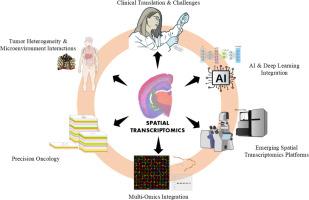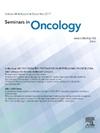从组织结构到临床洞察:实体肿瘤研究中的空间转录组学
IF 2.5
3区 医学
Q2 ONCOLOGY
引用次数: 0
摘要
癌症是一种高度异质性的疾病,其诊断、预后和治疗反应不仅取决于遗传改变,还取决于肿瘤微环境(TME)内细胞的复杂组织。空间转录组学——一套保留完整组织中基因表达空间背景的技术——已经彻底改变了我们破译肿瘤结构和细胞间通讯的能力。本文综述了空间转录组学技术的最新进展及其在实体肿瘤研究中的应用。我们首先描述了空间转录组学的演变,从早期的原位杂交方法到最先进的成像和测序平台。接下来,我们将讨论空间解析转录组学如何通过揭示肿瘤核心、侵袭边缘和免疫生态位的分子景观来改变癌症研究。空间转录组学与单细胞多组学和先进的计算算法的整合正在导致新的预后和预测性生物标志物的鉴定。尽管取得了巨大的进步,但在技术解决、数据处理、样品制备和临床标准化方面仍然存在挑战。最后,我们强调了新兴趋势-包括三维(3D)空间分析,多模式集成以及人工智能和深度学习的使用-设想空间转录组学将作为精确肿瘤学的关键工具的未来。总之,这些进展有望改进癌症生物标志物研究,并最终改善患者的治疗效果。本文章由计算机程序翻译,如有差异,请以英文原文为准。

From tissue architecture to clinical insights: Spatial transcriptomics in solid tumor studies
Cancer is a highly heterogeneous disease, and its diagnosis, prognosis, and therapeutic responsiveness depend not only on genetic alterations but also on the intricate organization of cells within the tumor microenvironment (TME). Spatial transcriptomics—a suite of techniques that preserves the spatial context of gene expression in intact tissue—has revolutionized our ability to decipher tumor architecture and intercellular communication. This review provides an in‐depth analysis of recent advancements in spatial transcriptomics technologies and their applications in solid tumor research. We first describe the evolution of spatial transcriptomics from early in situ hybridization methods to state‐of‐the‐art imaging‐ and sequencing‐based platforms. Next, we discuss how spatially resolved transcriptomics is transforming cancer research by revealing the molecular landscapes of tumor cores, invasive edges, and immunological niches. The integration of spatial transcriptomics with single‐cell multiomics and advanced computational algorithms is leading to the identification of novel prognostic and predictive biomarkers. Despite tremendous progress, challenges remain in terms of technical resolution, data processing, sample preparation, and clinical standardization. Finally, we highlight emerging trends—including three-dimensional (3D) spatial profiling, multimodal integration, and the use of artificial intelligence and Deep learning—to envision a future in which spatial transcriptomics will serve as a pivotal tool for precision oncology. Together, these developments promise to refine cancer biomarker studies and ultimately improve patient outcomes.
求助全文
通过发布文献求助,成功后即可免费获取论文全文。
去求助
来源期刊

Seminars in oncology
医学-肿瘤学
CiteScore
6.60
自引率
0.00%
发文量
58
审稿时长
104 days
期刊介绍:
Seminars in Oncology brings you current, authoritative, and practical reviews of developments in the etiology, diagnosis and management of cancer. Each issue examines topics of clinical importance, with an emphasis on providing both the basic knowledge needed to better understand a topic as well as evidence-based opinions from leaders in the field. Seminars in Oncology also seeks to be a venue for sharing a diversity of opinions including those that might be considered "outside the box". We welcome a healthy and respectful exchange of opinions and urge you to approach us with your insights as well as suggestions of topics that you deem worthy of coverage. By helping the reader understand the basic biology and the therapy of cancer as they learn the nuances from experts, all in a journal that encourages the exchange of ideas we aim to help move the treatment of cancer forward.
 求助内容:
求助内容: 应助结果提醒方式:
应助结果提醒方式:


